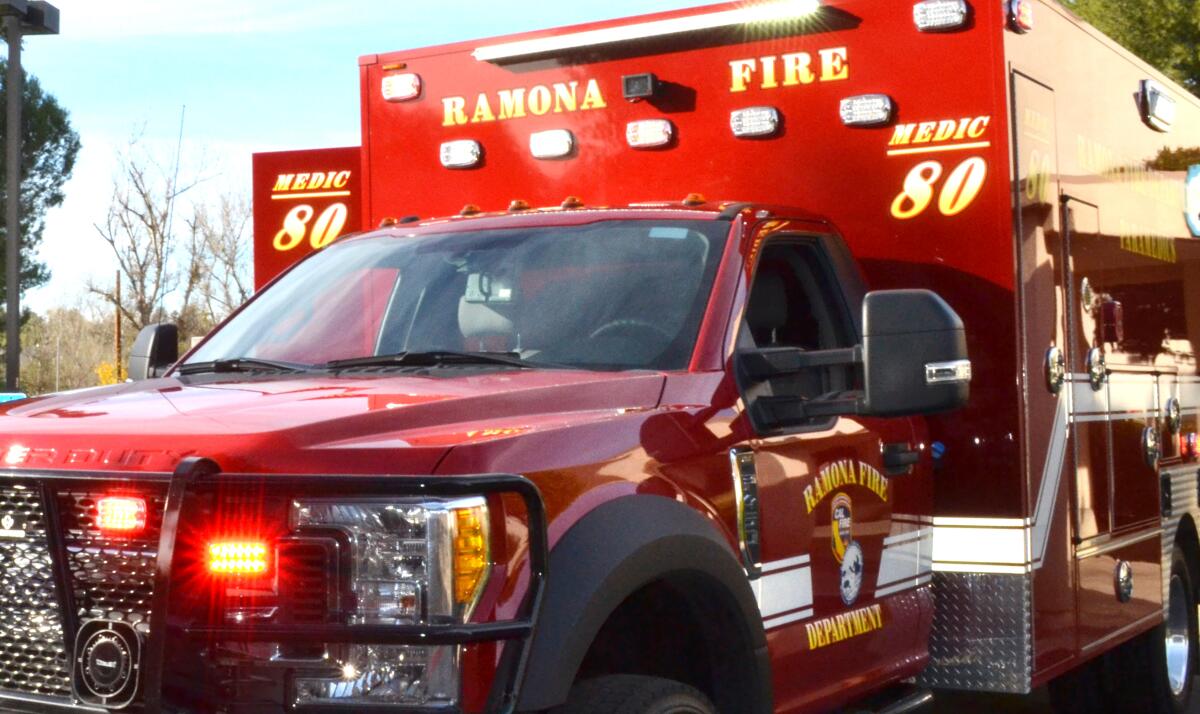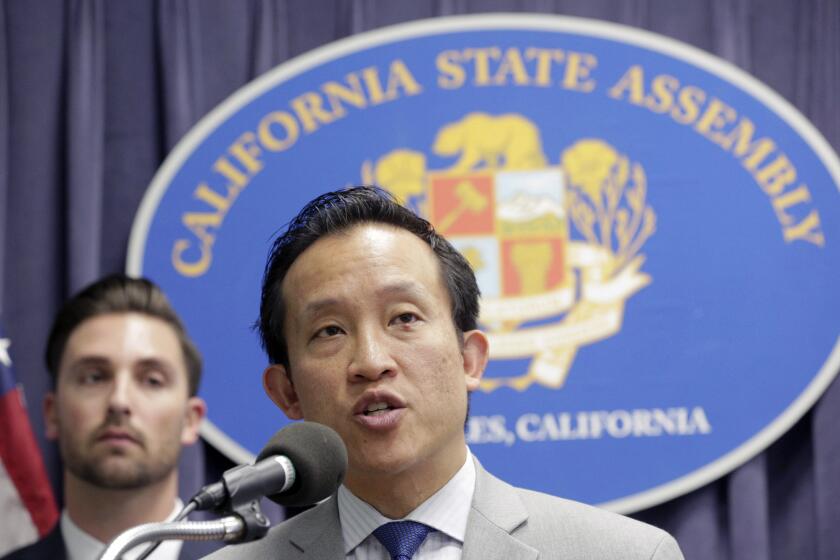New California law offers fresh protection from steep ambulance bills

- Share via
Last year, Jennifer Reisz’s college-age daughter, Megan, was kicked in the chest multiple times by the family’s horse. Megan fell to the ground, unable to move or speak. Though she was alone, her Apple Watch detected her distress and called 911.
She was taken to a hospital in Clovis, a city in Fresno County, near where the Reisz family lives. But the severity of Megan’s injuries — four broken ribs and a partly collapsed lung — prompted doctors to transport her 12 miles by ambulance to the Level 1 trauma center at Community Regional Medical Center in Fresno.
While Megan was still recovering at home from her injuries, she received a $2,400 bill from the ambulance company — after the family’s health plan had paid nearly $2,200.
“When we received the bill, I thought our insurance company was processing the claim incorrectly,” said Jennifer Reisz, an attorney who would spend hours on the phone with the health plan, the ambulance company and a few consumer advocates. She learned that the ambulance company was not in the health plan’s network and was permitted to bill patients for any uncovered portion of its charges — a practice known as balance billing.
California lawmakers have been trying for more than a decade to protect hospital patients from being hit with huge bills from doctors who aren’t part of their health insurer’s network.
Starting Jan. 1, ground ambulance operators will be barred from doing that, thanks to a new law signed by Democratic Gov. Gavin Newsom. California is the 14th state to provide some protection against balance billing for ground ambulance rides.
At the federal level, an advisory committee established under the No Surprises Act is working on a plan to address the problem nationally.
Both the federal law, which took effect in 2022, and a California law that predates it largely banned balance billing for hospital care and air ambulance services, but not ground ambulance services.
And that is hardly fair, since patients have zero control in a medical emergency over which ambulance company responds, whether it is in network, or how much it will charge.
Bernard J. Wolfson writes about the challenges consumers face in California’s health care landscape.
Send questions to [email protected].
In California, nearly three-quarters of emergency ground ambulance rides result in out-of-network bills. The average surprise bill for a ground ambulance ride in California is $1,209, the highest in the nation, according to a December study.
The new law, which applies to about 14 million Californians enrolled in state-regulated commercial health plans, limits how much a non-network ambulance operator can charge patients to the amount they would pay for an in-network ambulance.
The law also caps bills for uninsured people, stipulating they can’t be charged more than the Medi-Cal or Medicare rate, whichever is greater. (Medi-Cal is California’s Medicaid program, providing coverage to people with low income or disabilities.) And it prohibits ambulance operators and debt collectors from reporting patients to a credit rating agency or taking legal action against them for at least 12 months after the initial bill.
Under current law, people in distress sometimes decline to call an ambulance for fear of a huge bill, putting themselves or a loved one at risk, said Katie Van Deynze, policy and legislative advocate for Health Access California, which sponsored the legislation. With the new law, she added, “they will have peace of mind.”
Existing laws already protect Medicare and Medi-Cal beneficiaries from surprise ground ambulance bills. The new law does not cover the nearly 6 million Californians enrolled in the subset of employer-sponsored health plans that are federally regulated.
The advisory committee working on a federal fix agreed last week on nonbinding proposals that would, among other things, prohibit balance billing for the vast majority of ambulance rides and cap patients’ financial liability at $100. The committee plans to formally report its recommendations to Congress early next year for potential legislation.
California hospitals killed a measure aimed at protecting patients from surprise hospital bills
Under California’s new law, patients can expect to save an average of nearly $1,100 per emergency ambulance ride and over $800 per nonemergency ride in the first year, according to a legislative analysis conducted this year.
Health plans will be required to pay ambulance operators the rates set by county authorities, which the study said would increase the average amount insurers pay per ride by around $2,000.
Since ambulance rides account for a tiny percentage of overall health plan spending, those increases should not raise premiums by much.
But local authorities might be tempted to raise ambulance rates over time to increase revenue for publicly run ambulance operators, such as fire departments, said Loren Adler, associate director of the Brookings Schaeffer Initiative on Health Policy. That could prompt health plans to raise ambulance copays, offsetting some of the consumer savings from the new law, Adler added.
Jenn Engstrom, director of CalPIRG, an advocacy group that helped shepherd the law through the Legislature, said there will be built-in accountability, since the legislation requires public reporting of ambulance rates. “If we notice that things start to skyrocket, there will be a need for legislative action or local action,” Engstrom said.
Reisz said the ambulance company that transported her daughter wrote off the bill after she made it clear she had no intention of paying it — and after her health plan ponied up a little more. But, as she noted, not everyone is a lawyer adept at arguing their cause.
Even if you are no rhetorical wizard, you can take simple steps to protect yourself against errors or ambulance operators that disregard the new law.
Check your insurance policy to know your deductible and any copay or coinsurance should you ever need an ambulance. If you get an ambulance bill, don’t pay it right away. Check your insurer’s explanation of benefits to make sure what it says you owe matches what you think your cost-sharing amount should be. If the bill is higher, the ambulance company may be trying to pull a fast one. Call the company and tell it to knock the bill down. If it doesn’t, file a complaint with your health plan and include a copy of the bill.
If you disagree with your plan’s decision, or it takes more than 30 days for the plan to respond, take your complaint to the regulator.
The new law requires your insurer to tell you if your health plan is regulated by the state and thus subject to the statute. If it is, the regulator is likely to be the Department of Managed Health Care. You can contact that agency online (www.healthhelp.ca.gov) or by phone at (888) 466-2219. If your health plan is regulated by the Department of Insurance, you can file a complaint online (www.insurance.ca.gov) or call (800) 927-4357.
Another good resource is the Health Consumer Alliance, which offers free legal assistance in multiple languages. Call (888) 804-3536.
KFF Health News, formerly known as Kaiser Health News, is a national newsroom that produces in-depth journalism about health issues and is one of the core operating programs at KFF — the independent source for health policy research, polling and journalism.
More to Read
Inside the business of entertainment
The Wide Shot brings you news, analysis and insights on everything from streaming wars to production — and what it all means for the future.
You may occasionally receive promotional content from the Los Angeles Times.











